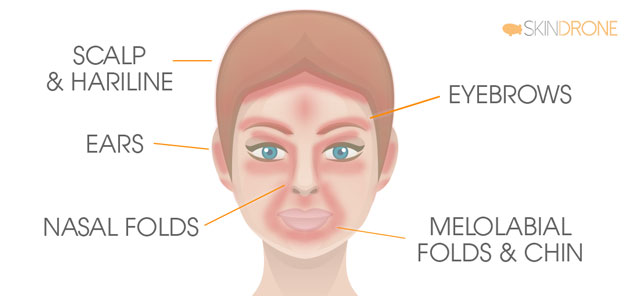- Seborrheic dermatitis is a common skin condition affecting 1-5% of adults.
- It’s often confused with dandruff, which is considered a milder form.
- Key symptoms include dry, greasy, flaky, itchy, and red skin patches.
- Common areas affected are the scalp, face (especially around the nose and eyebrows), chest, and genitals.
- While treatable, it can significantly impact quality of life.
Seborrheic dermatitis is a skin condition that affects between 1% and 5% of healthy adults [1]. Scalp flaking, a common symptom, is self-reported at much higher rates, closer to 40% [2].
This condition is more prevalent in individuals with weakened immune systems. For instance, studies show rates as high as 53% in people infected with HIV-1 [3].
While men appear to be slightly more susceptible than women, age is a more significant factor. Ethnicity, however, doesn’t seem to play a notable role [4].
Who is Most Likely to Get Seborrheic Dermatitis?
Seborrheic dermatitis is most frequently observed in these age groups:
- Infants: Within the first 3 to 4 months of life (infantile seborrheic dermatitis or “cradle cap”)
- Adolescents: Around the time of puberty
- Adults: Individuals over 50 years old [5]
Regardless of age, seborrheic dermatitis is increasingly recognized as a condition that can significantly diminish a person’s quality of life [6].

Recognizing Seborrheic Dermatitis: Key Symptoms
How can you determine if you have seborrheic dermatitis and not another skin issue? The easiest way is to check for a combination of these common symptoms:
- Dry Skin: Skin may feel tight and rough.
- Greasy Patches with Flakes: Areas of skin appear oily and are covered in scales.
- White or Yellow Scales: Flakes can be white to yellowish in color.
- Redness and Irritation: Inflammation causing the skin to turn red and feel sensitive.
- Itching, Burning, or Crawling Sensations: Uncomfortable skin sensations ranging from mild itching to burning or a crawling feeling.
When these symptoms are present on the scalp, it’s typically called dandruff. However, when these symptoms appear on the face, it’s almost always diagnosed as seborrheic dermatitis.
Seborrheic dermatitis on areas other than the scalp can resemble eczema. These two conditions share similarities, but a key difference is the greasiness and scale buildup characteristic of seborrheic dermatitis. Eczema usually presents with drier crusting and less pronounced flaking.
Dandruff vs. Seborrheic Dermatitis: Are They the Same?
Most experts consider dandruff to be a milder form of seborrheic dermatitis, essentially viewing them as the same condition on a spectrum [7].
However, this isn’t a universally held view. Some researchers argue that “dandruff” should be a broad term for any scalp flaking, regardless of the underlying cause [8].
Others point to differences in how the conditions manifest across different age groups. Dandruff tends to decrease with age, while seborrheic dermatitis remains common, or even increases, among older adults [9].

Common Locations for Seborrheic Dermatitis
Seborrheic dermatitis commonly affects areas with a higher density of sebaceous glands. Above the neck, these areas include:
- Scalp
- Hairline
- Eyebrows
- Nasal folds
- Melolabial folds (lines from the nose to the corners of the mouth)
- Ears
- Chin
- Other hair-bearing areas of the face
Below the neck, common areas include:
- Central chest
- Genital region

Treating seborrheic dermatitis on the scalp (dandruff) is generally easier. Over-the-counter dandruff shampoos are often effective in providing relief.
Facial seborrheic dermatitis can be more challenging to manage, possibly due to its potentially more aggressive nature and the increased sensitivity of facial skin.
Why These Specific Areas? The Role of Sebaceous Glands and Skin Temperature
The prevailing theory is that seborrheic dermatitis occurs in these areas due to high sebaceous activity – meaning these areas produce more sebum (oil) and sweat [10].
However, some research suggests other factors might be involved. One study using thermal imaging explored skin temperature as a contributing factor in the location of seborrheic dermatitis. The study indicated that seborrheic dermatitis more frequently affected warmer areas of the face [].
Could Warmer Skin Encourage Bacterial Growth?
It’s possible that slightly elevated skin temperature in these areas creates a more favorable environment for bacteria. Increased bacterial presence might then contribute to triggering seborrheic dermatitis.
While this study offers an interesting perspective on the potential role of skin temperature, it’s important to note that it was small and not specifically conducted on individuals with seborrheic dermatitis. Therefore, it is not conclusive.
Nevertheless, examining thermal images of the face reveals a pattern that strikingly resembles the typical “butterfly” distribution often seen in seborrheic dermatitis.

Key Takeaways: Seborrheic Dermatitis Summary
This section has covered essential aspects of seborrheic dermatitis. Here’s a quick recap of the main points:
- Seborrheic dermatitis affects roughly 1% to 5% of healthy adults; dandruff is far more common, affecting up to 40%.
- People with weakened immune systems are at higher risk, with rates reaching 53% in HIV-1 patients.
- Age is a more significant risk factor than gender or ethnicity.
- Seborrheic dermatitis is most prevalent in infants, adolescents, and adults over 50.
- Key symptoms include skin flakes, itching, redness, tightness, and irritation.
- Dandruff is largely considered a mild form of seborrheic dermatitis, though some debate exists.
- Commonly affected areas include the scalp, face (hairline, eyebrows, nasal folds, etc.), ears, chin, central chest, and genital area.
- High sebaceous gland activity is the primary explanation for why certain areas are more prone to seborrheic dermatitis, but skin temperature may also play a role.

No Comments
Be the first to start a conversation